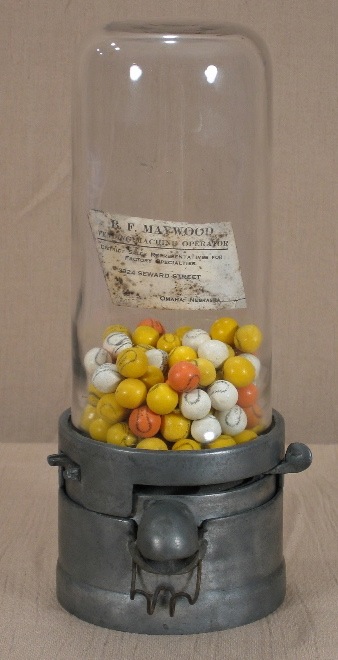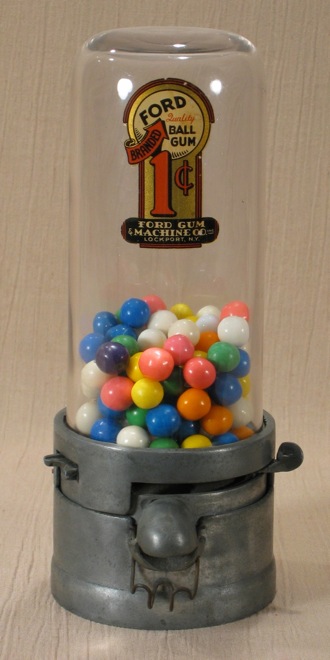___________________________________________________________________________________________
Penny King


___________________________________________________________________________________________


The Penny King System, Detroit, MI, c. 1930's, 11 1/2". The Penny King is a small-footprint bar or countertop vendor reminiscent of the Grandbois and Vendex Peanut. The body is cast aluminum and the globe is glass. The bottom is embossed "THE PENNY KING SYSTEM, 12394 ROSELAWN, DETROIT, MICH." Until I saw that I thought this was just a gumball machine---I didn't know it was a system.
I've seen several versions of this model. One variation involves the gumball spout. The examples pictured above have a cast aluminum "hood" and a wire basket to catch the ball. I've seen a version with no hood and a solid cast aluminum piece under the exit spout, which is more common than the version shown above. Both of these versions are pictured in Silent Salesmen Too, page 122. Another variation is a private label: Instead of "The Penny King System" embossed into the base, the machine's bottom is embossed "Flatbush Gum Co., Brooklyn, NY." I also know of an example with a blank bottom, but this is on a King aspirin vendor which is technically a different model made by Penny King. Lastly, I've seen Penny Kings with globes that are about two-thirds the height of the conventional globe shown above. The short globes have 2 dimples opposite each other on the bottom half of the globe, and these have no discernable function. I'm not sure this globe is factory-original, but I see them often enough to think that some Penny Kings were used on route with the short globe even if it's not factory-original.
Penny Kings also came as Penny King Twins, which is 2 Penny Kings joined together at the base. I think the bases were joined with a removable bracket rather than molded together at the factory, and if so then this is just a Penny King with a bracket option. If the bases were molded together then I'd consider the Twins to be a separate model. I've not inspected one live, but the picture in Silent Salesmen Too looks as though the bridge wasn't molded into either base. The Penny King pictured above as 2 holes directly in back of the base---one directly over the other---and I suspect that the bracket shown on the Twins pictured in Silent Salesmen Too wrapped a bit around the back and was attached to each base through these holes.
The Penny King is a relatively common model but is seldom found with a decal. The examples pictured above are 100% original. The "decal" on the left example is a vendor label that tells you (I presume) who owned the machine. It's not a pretty decal, but it's old and provides some history for the specific machine---that's always good. In case you're curious (and who wouldn't be?), the label says the following:
District Sales Representatives for
Factory Specialities
3824 Seward Street
Omaha, Nebraska
The right example has a Ford decal that some collectors may not consider technically correct, but it's been on the globe for a long, long time. The era of this particular Ford decal is consistent with the Penny King's era, and therefore may very well be original to the globe. Nobody said that a Penny King could use only a Penny King decal, especially if the vendor was selling Ford gum from said Penny King machine.
___________________________________________________________________________________________
___________________________________________________________________________________________
©Small Vintage Vending 2013